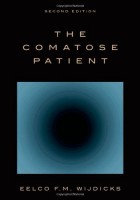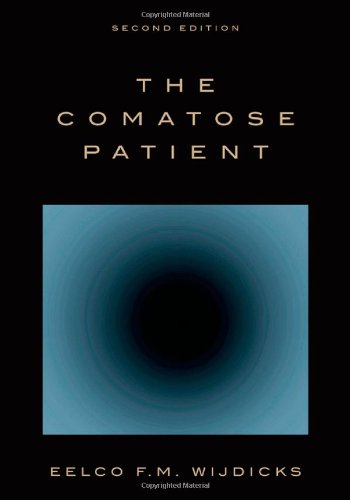 Editor: Eelco F.M. Wijdicks, MD
Editor: Eelco F.M. Wijdicks, MD
Publisher: Oxford University Press – 784 pages
Book Review by: Bina Odhar
This is one of the very few lengthy medical books available on the subject of coma, especially on the comatose patient. I am not sure of the reason for this rarity; perhaps this subspecialty of neurology is not a very popular one in medical schools because of the complexity of understanding the state of coma.
While the word coma is related to a Greek word meaning deep sleep, that is not what it is, explains Dr. Wijdicks in his Preface. Most of us will admit that when we learn that someone we know has fallen into a coma, we are fearful that he or she may never recover from that condition and may die; we are afraid that that person is now near death.
The author points out that even physicians become apprehensive when one of their own (and sometimes another doctor’s) patients slips into a comatose state. This is especially true in instances when the cause of coma is uncertain.
In most instances, coma is the result of severe brain injury or a “calamity,” states Dr. Wijdicks, who has extensive knowledge and experience on coma. He writes: “the basic principles of neurologic examination and localization have not changed,” but “the role of neuroimaging, in particular computed tomography (CT) and magnetic resonance imaging (MRI) has become hugely important.”
The results obtained from examining patients through CT and MRI are now widely studied and used in determining the prognosis or possible outcome in each case. Also, the treatment options for comatose patients have become better defined through the use of these diagnostic techniques.
This book takes a fresh and contemporary look on coma and aims to become a new clinical and practical book on the proper management of the comatose patient. It is divided into two Parts. Part I presents current clinical knowledge of the various comatose states.
Part II provides the clinical approaches to treating and managing comatose patients based on the type and severity of the injury they sustained. We list below the first 11 chapters that fall under Part I, but cannot enumerate due to space limitations, some 100 other causes of coma.
- Understanding, Diagnosing, and Care of Comatose States
- A History of Coma: Evolution of Ideas
- The Neuroscience of the Awake State
- Neurologic Examination of the Comatose Patient and Localization Principles
- The Clinical Diagnosis of Prolonged Impaired Consciousness
- The Clinical Diagnosis of Brain Death
- Neuroimaging, Neurophysiology, and Neuropathology
- Clinical Diagnosis and Decisions
- Medical Care of the Comatose Patient
- Recovery and Rehabilitation
- Law and Bioethics
- Media and Popular Culture
- The Clinical Approach to the Comatose Patient : Chapters 12 through 112
This book contains over 300 illustrations. Each of the chapters is amply illustrated with scans – angiograms, CTs, MRIs, radiographs, and other types – and visuals such as charts, drawings, and tables to make you better understand the topics being discussed. Two sections – Conclusions and References – are found at the end each chapter.
In Part II, each chapter begins with an interesting and highly useful illustration entitled A Conversation wherein two or more doctors discuss the patients’ conditions.
For example in chapter 13 entitled Comatose and Traumatic Brain Injury, the conversation goes like this:
Physician A: (on the phone with Physician B): We just admitted a 28-year-old male struck by an all-terrain vehicle. He was paralyzed and intubated. The pupils were 7 mm, but reactive to light. CT scan shows diffuse axonal injury, subcutaneous emphysema, and a pneumothorax.
Physician B: More systemic injury should be suspected.
Physician A: Multiple rib fractures were noted, and bimalleolar ankle fractures. CT pelvis was normal.
Physician B: He needs an ICP monitor to follow his course.
This is an excellent illustrative, highly useful and insightful book on using present-day neuroimaging technologies in understanding coma and the diagnosing, treating, and managing comatose patients.
Author:
Eelco F.M.Wijdicks, MD, PhD, FACP, FNCS, FANA was born in Leiden, the Netherlands. He earned his MD from the University of Leiden, did his residency and PhD at Erasmus University in Rotterdam and became staff neurologist at University Medical Center Utrecht. He was a visiting scientist and research fellow at Neurologic-Neurosurgical Intensive Care Unit at Massachusetts General Hospital in Boston.
In 1992, he joined the Department of Neurology at Mayo Clinic College of Medicine. He is a fellow of the American College of Physicians, fellow of the American Neurologic Association and fellow of the Neurocritical Care Society. He is Professor of Neurology and Chair of the Division of Critical Care Neurology and currently practicing in the Neurosciences Intensive Care Unit at Saint Mary’s Hospital at Mayo Clinic in Rochester, Minnesota.
He is the founding editor of the journal Neurocritical Care, the official journal of the Neurocritical Care Society. He has over 650 research papers, book chapters, topic reviews and editorials to his credit. He is the senior author of the American Academy of Neurology guidelines on prediction of outcome in comatose survivors after cardiopulmonary resuscitation (2006) and guideline on the diagnosis of brain death (2010).
He single-authored multiple books pertaining to the care of critically ill neurologic patients. His books received the Commendable Book Award of the British Medical Association (2004) and the Honorable Mention book Award of the American Medical Writers Association (2008).







